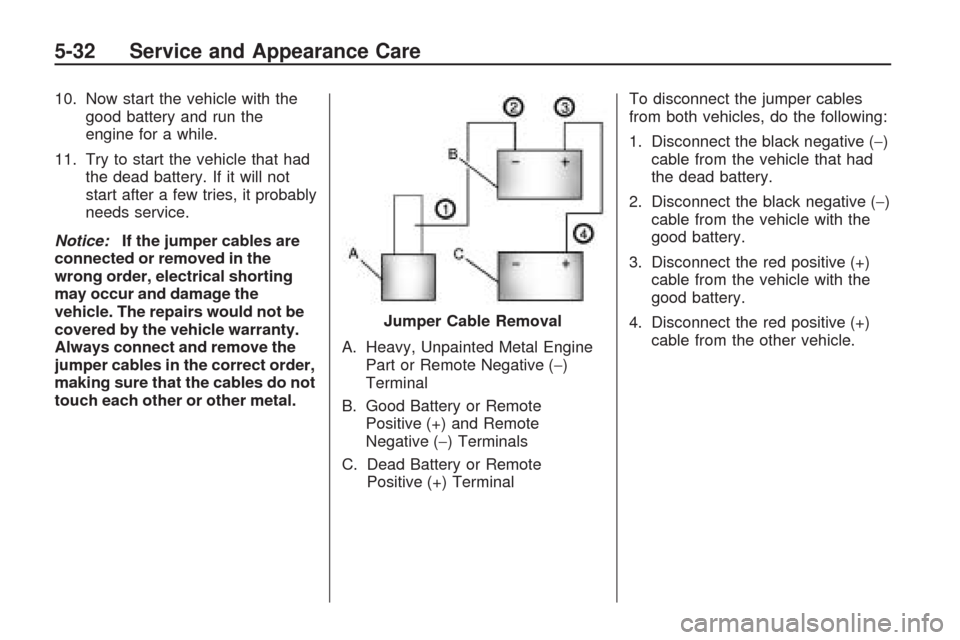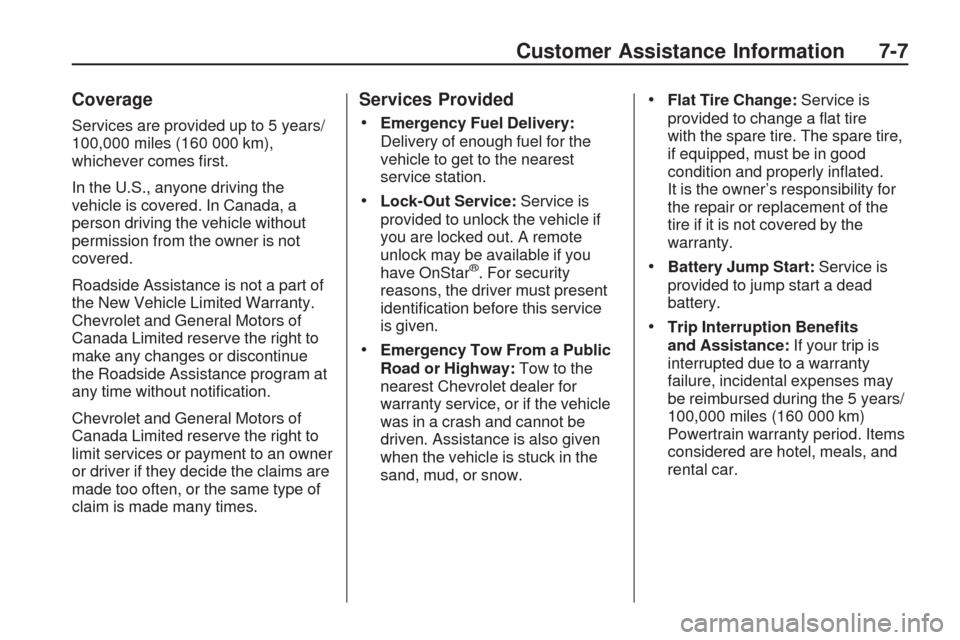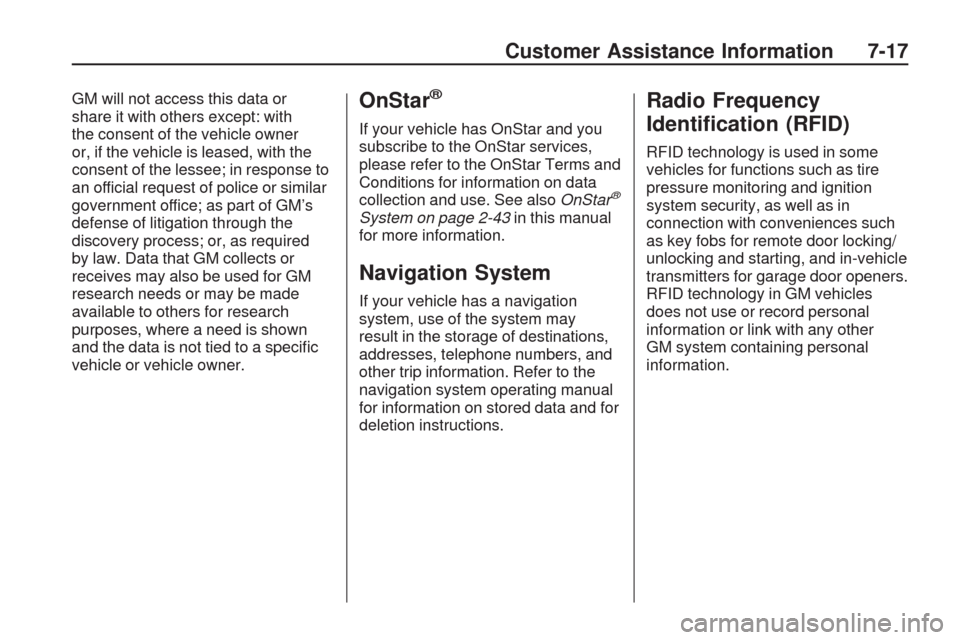2009 CHEVROLET TRAVERSE remote start
[x] Cancel search: remote startPage 312 of 422

Notice:If you leave the radio or
other accessories on during the
jump starting procedure, they
could be damaged. The repairs
would not be covered by the
warranty. Always turn off the
radio and other accessories
when jump starting the vehicle.
3. Turn off the ignition on both
vehicles. Unplug unnecessary
accessories plugged into the
cigarette lighter or the accessory
power outlets. Turn off the radio
and all lamps that are not needed.
This will avoid sparks and help
save both batteries. And it could
save the radio!
4. Open the hoods and locate the
positive (+) and negative (−)
terminal locations on the other
vehicle. Your vehicle has a
remote positive (+) and a remote
negative (−) jump starting
terminal. SeeEngine
Compartment Overview on
page 5-10for more information
on the terminal locations.{CAUTION
Using a match near a battery can
cause battery gas to explode.
People have been hurt doing this,
and some have been blinded. Use
a �ashlight if you need more light.
Be sure the batteries have
enough water. You do not need to
add water to the ACDelco
®
battery (or batteries) installed in
your new vehicle. But if a battery
has �ller caps, be sure the right
amount of �uid is there. If it is
low, add water to take care of that
�rst. If you do not, explosive gas
could be present.
Battery �uid contains acid that
can burn you. Do not get it on
you. If you accidentally get it in
your eyes or on your skin, �ush
the place with water and get
medical help immediately.
{CAUTION
Fans or other moving engine
parts can injure you badly. Keep
your hands away from moving
parts once the engine is running.
5. Check that the jumper cables do
not have loose or missing
insulation. If they do, you could
get a shock. The vehicles
could be damaged too.
Before you connect the cables,
here are some basic things you
should know. Positive (+) will go
to positive (+) or to a remote
positive (+) terminal if the vehicle
has one. Negative (−) will go to a
heavy, unpainted metal engine
part or to a remote negative (−)
terminal if the vehicle has one.
5-30 Service and Appearance Care
Page 314 of 422

10. Now start the vehicle with the
good battery and run the
engine for a while.
11. Try to start the vehicle that had
the dead battery. If it will not
start after a few tries, it probably
needs service.
Notice:If the jumper cables are
connected or removed in the
wrong order, electrical shorting
may occur and damage the
vehicle. The repairs would not be
covered by the vehicle warranty.
Always connect and remove the
jumper cables in the correct order,
making sure that the cables do not
touch each other or other metal.A. Heavy, Unpainted Metal Engine
Part or Remote Negative (−)
Terminal
B. Good Battery or Remote
Positive (+) and Remote
Negative (−) Terminals
C. Dead Battery or Remote
Positive (+) TerminalTo disconnect the jumper cables
from both vehicles, do the following:
1. Disconnect the black negative (−)
cable from the vehicle that had
the dead battery.
2. Disconnect the black negative (−)
cable from the vehicle with the
good battery.
3. Disconnect the red positive (+)
cable from the vehicle with the
good battery.
4. Disconnect the red positive (+)
cable from the other vehicle. Jumper Cable Removal
5-32 Service and Appearance Care
Page 330 of 422

The TPMS sensor matching process
is outlined below:
1. Set the parking brake.
2. Turn the ignition switch to
ON/RUN with the engine off.
3. Press the Remote Keyless
Entry (RKE) transmitter’s LOCK
and UNLOCK buttons at the
same time for approximately
�ve seconds. The horn sounds
twice to signal the receiver
is in relearn mode and TIRE
LEARNING ACTIVE message
displays on the DIC screen.
4. Start with the driver side front tire.
5. Remove the valve cap from the
valve cap stem. Activate the
TPMS sensor by increasing or
decreasing the tire’s air pressure
for �ve seconds, or until a horn
chirp sounds. The horn chirp,
which may take up to 30 seconds
to sound, con�rms that the sensor
identi�cation code has been
matched to this tire and wheel
position.6. Proceed to the passenger side
front tire, and repeat the
procedure in Step 5.
7. Proceed to the passenger side
rear tire, and repeat the
procedure in Step 5.
8. Proceed to the driver side rear
tire, and repeat the procedure
in Step 5. The horn sounds
two times to indicate the sensor
identi�cation code has been
matched to the driver side rear
tire, and the TPMS sensor
matching process is no longer
active. The TIRE LEARNING
ACTIVE message on the
DIC display screen goes off.
9. Turn the ignition switch to
LOCK/OFF.
10. Set all four tires to the
recommended air pressure level
as indicated on the Tire and
Loading Information label.
11. Put the valve caps back on the
valve stems.Tire Inspection and
Rotation
We recommend that you
regularly inspect the vehicle’s
tires, including the spare tire, if
the vehicle has one, for signs of
wear or damage. SeeWhen It Is
Time for New Tires on page 5-50
for more information.
Tires should be rotated
every 5,000 to 8,000 miles
(8 000 to 13 000 km). See
Scheduled Maintenance on
page 6-3.
The purpose of a regular tire
rotation is to achieve a uniform
wear for all tires on the vehicle.
This will ensure that the vehicle
continues to perform most like it
did when the tires were new.
5-48 Service and Appearance Care
Page 399 of 422

Coverage
Services are provided up to 5 years/
100,000 miles (160 000 km),
whichever comes �rst.
In the U.S., anyone driving the
vehicle is covered. In Canada, a
person driving the vehicle without
permission from the owner is not
covered.
Roadside Assistance is not a part of
the New Vehicle Limited Warranty.
Chevrolet and General Motors of
Canada Limited reserve the right to
make any changes or discontinue
the Roadside Assistance program at
any time without noti�cation.
Chevrolet and General Motors of
Canada Limited reserve the right to
limit services or payment to an owner
or driver if they decide the claims are
made too often, or the same type of
claim is made many times.
Services Provided
Emergency Fuel Delivery:
Delivery of enough fuel for the
vehicle to get to the nearest
service station.
Lock-Out Service:Service is
provided to unlock the vehicle if
you are locked out. A remote
unlock may be available if you
have OnStar
®. For security
reasons, the driver must present
identi�cation before this service
is given.
Emergency Tow From a Public
Road or Highway:Tow to the
nearest Chevrolet dealer for
warranty service, or if the vehicle
was in a crash and cannot be
driven. Assistance is also given
when the vehicle is stuck in the
sand, mud, or snow.
Flat Tire Change:Service is
provided to change a �at tire
with the spare tire. The spare tire,
if equipped, must be in good
condition and properly in�ated.
It is the owner’s responsibility for
the repair or replacement of the
tire if it is not covered by the
warranty.
Battery Jump Start:Service is
provided to jump start a dead
battery.
Trip Interruption Bene�ts
and Assistance:If your trip is
interrupted due to a warranty
failure, incidental expenses may
be reimbursed during the 5 years/
100,000 miles (160 000 km)
Powertrain warranty period. Items
considered are hotel, meals, and
rental car.
Customer Assistance Information 7-7
Page 409 of 422

GM will not access this data or
share it with others except: with
the consent of the vehicle owner
or, if the vehicle is leased, with the
consent of the lessee; in response to
an official request of police or similar
government office; as part of GM’s
defense of litigation through the
discovery process; or, as required
by law. Data that GM collects or
receives may also be used for GM
research needs or may be made
available to others for research
purposes, where a need is shown
and the data is not tied to a speci�c
vehicle or vehicle owner.OnStar®
If your vehicle has OnStar and you
subscribe to the OnStar services,
please refer to the OnStar Terms and
Conditions for information on data
collection and use. See alsoOnStar
®
System on page 2-43in this manual
for more information.
Navigation System
If your vehicle has a navigation
system, use of the system may
result in the storage of destinations,
addresses, telephone numbers, and
other trip information. Refer to the
navigation system operating manual
for information on stored data and for
deletion instructions.
Radio Frequency
Identi�cation (RFID)
RFID technology is used in some
vehicles for functions such as tire
pressure monitoring and ignition
system security, as well as in
connection with conveniences such
as key fobs for remote door locking/
unlocking and starting, and in-vehicle
transmitters for garage door openers.
RFID technology in GM vehicles
does not use or record personal
information or link with any other
GM system containing personal
information.
Customer Assistance Information 7-17
Page 416 of 422

Hood
Checking Things Under....... 5-9
Release............................ 5-9
Horn .................................... 3-5
How to Wear Safety Belts
Properly..........................1-17
I
Ignition Positions..................2-21
Infants and Young Children,
Restraints........................1-29
In�ation - Tire Pressure.........5-42
Instrument Panel
Brightness.......................3-13
Cluster............................3-31
Overview........................... 3-4
Storage Area....................2-52
Introduction........................... 6-1
J
Jump Starting......................5-29
K
Keyless Entry, Remote
Operation.......................... 2-4
Keyless Entry System............ 2-3
Keys.................................... 2-2
L
Labeling, Tire Sidewall..........5-37
Lamp
Malfunction Indicator.........3-39
Lamps
Courtesy.........................3-14
Dome .............................3-14
Dome Lamp Override........3-14
Reading..........................3-15
Lap-Shoulder Belt................1-22
LATCH System for Child
Restraints........................1-35
Liftgate
Carbon Monoxide.............2-10
Liftgate, Power....................2-11
Lighting
Delayed Entry..................3-15
Delayed Exit....................3-15
Entry..............................3-14
Parade Dimming...............3-15Lights
Airbag Readiness.............3-33
Antilock Brake System
(ABS) Warning..............3-37
Brake System Warning......3-36
Charging System..............3-34
Cruise Control..................3-43
Engine Coolant
Temperature Warning.....3-38
Exterior Lamps.................3-11
Flash-to-Pass..................... 3-7
Highbeam On...................3-43
High/Low Beam Changer..... 3-7
Oil Pressure.....................3-42
Passenger Airbag Status
Indicator.......................3-33
Safety Belt Reminders.......3-32
Security...........................3-43
StabiliTrak
®Indicator.........3-37
Tire Pressure...................3-39
Tow/Haul Mode................3-43
Loading Your Vehicle............4-16
Locks
Delayed Locking................. 2-8
Door ................................. 2-8
Lockout Protection.............. 2-9
i-6 INDEX
Page 419 of 422

Rearview Mirror, Automatic
Dimming ..........................2-31
Rearview Mirrors..................2-31
Reclining Seatbacks............... 1-8
Recommended Fluids and
Lubricants........................6-12
Recreational Vehicle Towing . . . 4-21
Reimbursement Program,
GM Mobility....................... 7-6
Remote Keyless Entry (RKE)
System............................. 2-3
Remote Keyless Entry (RKE)
System, Operation.............. 2-4
Remote Vehicle Start............. 2-6
Removing the Flat Tire and
Installing the Spare Tire.....5-68
Removing the Spare Tire
and Tools........................5-66
Replacement Bulbs..............5-34
Replacement Parts,
Maintenance....................6-14
Reporting Safety Defects to
General Motors................7-14
Reporting Safety Defects
to the Canadian
Government.....................7-14
Reporting Safety Defects
to the United States
Government.....................7-14Restraint System Check
Checking the Restraint
Systems.......................1-59
Replacing Restraint System
Parts After a Crash........1-60
Retained Accessory
Power (RAP) ....................2-22
Roadside Assistance
Program............................ 7-6
Rocking Your Vehicle to
Get it Out ........................4-16
Roof
Sunroof...........................2-56
Running the Vehicle While
Parked............................2-30
S
Safety Belt Reminders..........3-32
Safety Belts
Care of ...........................5-80
Extender.........................1-27
How to Wear Safety Belts
Properly.......................1-17
Lap-Shoulder Belt.............1-22
Safety Belts Are for
Everyone.....................1-14
Use During Pregnancy......1-26Safety Defects
Reporting to Canadian
Government..................7-14
Reporting to
General Motors.............7-14
Reporting to the United
States Government........7-14
Safety Warnings and Symbols.... iii
Scheduled Maintenance.......... 6-3
Additional Required
Services........................ 6-6
Scheduling Appointments........ 7-8
Sealant Kit, Tire...................5-57
Seats
Driver Seat Height
Adjuster......................... 1-3
Head Restraints................. 1-2
Heated and Cooled Seats.... 1-5
Heated Seats..................... 1-5
Manual Lumbar.................. 1-4
Memory, Mirrors................. 1-6
Power Lumbar ................... 1-5
Power Seats...................... 1-4
Rear Seat Operation........... 1-9
Reclining Seatbacks............ 1-8
Third Row Seat................1-12
Second Row Center
Console..........................2-53
INDEX i-9
Page 420 of 422

Secondary Latch System.......5-72
Securing a Child Restraint
Rear Seat Position............1-41
Right Front Seat Position . . . 1-43
Security Light......................3-43
Service................................ 5-3
Accessories and
Modi�cations.................. 5-3
Adding Equipment to the
Outside of the Vehicle..... 5-4
Doing Your Own Work........ 5-4
Engine Soon Lamp...........3-39
Publications Ordering
Information...................7-15
Scheduling Appointments..... 7-8
Service Parts Identi�cation
Label..............................5-85
Servicing Your
Airbag-Equipped Vehicle....1-57
Setting the Clock.................3-74
Sheet Metal Damage............5-84
Shifting
Out of Park.....................2-29
Shifting Into Park.................2-28
Signals, Turn and
Lane-Change..................... 3-6Spare Tire
Compact.........................5-77
Installing..........................5-68
Removing........................5-66
Storing............................5-74
Speci�cations and
Capacities.......................5-92
Speedometer.......................3-32
StabiliTrak
®Indicator Light.....3-37
StabiliTrak®System............... 4-5
Start Vehicle, Remote............. 2-6
Starting the Engine..............2-22
Steering............................... 4-8
Steering Wheel Controls,
Audio............................3-125
Steering Wheel, Tilt and
Telescopic......................... 3-6
Storage Areas
Cargo Management
System........................2-55
Center Console................2-52
Convenience Net..............2-55
Cupholders......................2-52
Glove Box.......................2-52
Instrument Panel..............2-52
Luggage Carrier...............2-54
Second Row Center
Console.......................2-53Storing the Tire Sealant and
Compressor Kit................5-64
Stuck in Sand, Mud, Ice,
or Snow..........................4-16
Sun Visors..........................2-16
Sunroof..............................2-56
T
Tachometer.........................3-32
Taillamps
Turn Signal, Stoplamps and
Sidemarker Lamps.........5-33
Telescopic Wheel................... 3-6
Text Telephone (TTY) Users.... 7-4
Theft-Deterrent Feature.......3-125
Theft-Deterrent Systems........2-16
Content Theft-Deterrent.....2-16
PASS-Key
®III+ Electronic
Immobilizer...................2-18
PASS-Key
®III+ Electronic
Immobilizer Operation....2-18
Third-Row Seats..................1-12
Tilt Wheel............................. 3-6
Time, Setting.......................3-74
Tire
Pressure Light..................3-39
i-10 INDEX